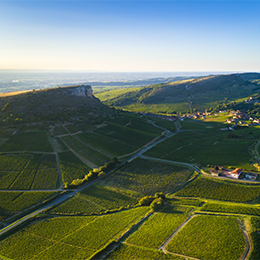The winegrowing area of the Mâconnais is characterized by highly diverse subsoil that was formed around 200 million years ago. Bordered on east and west by the valleys of the Saône and the Grosne, the hills of the Mâconnais were created from an ensemble of ranges, separated by parallel faults. These geological nuances can be found in the palette of wines produced from two distinct ensembles.
Leaning towards the Saône, the hills of the Mâconnais form a succession of parallel blocks, interspersed by faults and limestone ridges. Overlooking the valley of the Grosne to the west, their jagged slopes look down over geological formations that are more than 150 million years old.
The terroir here is rich in calcium and ideal for growing the white Chardonnay grape varietal. In the south, the subsoil is silica-rich marl with chert limestone (siliceous concretions), and crinoidal limestone with sandstone outcrops. This terrain is home to varietals for making white wines and the Gamay grape.
A symbolic feature of the Mâconnais, the Roche de Solutré has refused to succumb to erosion for millennia. It owes this resistance to crinoidal limestone. This extremely hard rock is a former coral massive, composed of the fossils of marine animals similar to sea urchins, formed 195 million years ago in a shallow, warm sea. This distinctive spur has, since then, looked down over the plots of Pouilly-Fuissé.

From Tournus to Clessé, the outcrops are mainly of brown and calcic limestone. A legacy from the Middle Jurassic era, in places they are mixed with rendzina, a shallow soil formed by the weathering of the limestone bedrock. Combined with a favorable aspect and elevation, they result in an excellent location for Chardonnay. This combination, in the hands of the winegrowers of the Mâconnais, results in white wines with good keeping potential, which are rounded and sophisticated, such as the Viré-Clessé appellation.

The Mâconnais reveals a different face from the village of Verzé. The south of the region has siliceous, sandy and clay soil, combined with chert (light limestone concretions) and sandstone pebbles. This has historically been a place where the red Gamay grape with its white juice has flourished. Today, this area on the southern edge of the Bourgogne region is shared with white varietals.
The limestone cornices like Vergisson or Solutré are home to a production of rich, well-structured wines.
The vines of Pouilly-Fuissé and Saint-Véran, towards a Premier Cru classification
Since 2003, winemakers from Pouilly-Fuissé, Pouilly-Loché, Pouilly-Vinzelles and Saint-Véran have been campaigning for the recognition of a hierarchy in their production from the Institut National des Appellations et de la Qualité (INAO). The geological qualities of the various terroirs presented would see more than 400 hectares of vines reclassified as Premier Cru if their campaign is successful.